"Remember Goliad"
but "Texans are Forgetting Goliad"
Created: 05/02/12
Modified: 05/05/12
In April, 2012 we took a historical vacation to South Texas.
We went to San Antonio, Goliad, Corpus Christi, Kingsville, then back to San Antonio, then Lockhart, and finally home.
We saw Natural Bridge Caverns, Mission San Jose, the Alamo, the site of the Fannin massacre in Goliad, the USS Lexington in Corpus Christi bay, the King Ranch north of Kingsville.
We ate at Oma's Haus (New Braunfels), Republic of Texas (River Walk), La Fonda on Main (San Antonio), Snoopy's Pier (Padre Island), and Kreuz market (Lockhart).
I didn't take pics inside Kreuz market or Natural Bridge Caverns, but here are the rest of the places.
Texas won it's independence from Mexico at the battle of San Jacinto on April 21,1836.
But preceeding the battle at San Jacinto were two major encounters (both massacres), the battle at the Alamo 03/06,1836, a massacre, and the battle at Coleto Creek 03/20,1836 and subsequent Goliad Massacre 03/27,1836.
During the battle at Jan Jacinto the battle cry of the Texas Army was "Remember the Alamo, Remember Goliad" to honor the men who died at both massacres.
Colonel Travis and his men at the Alamo fought a 13 day delaying action from Feb. 23,1836 until Mar. 6,1836 when the Alamo fell and all 186 defenders massacred.
Colonel Fannin had previously occupied the Presidio La Bahia, at Goliad, and after the fall of the Alamo was ordered to retreat by Sam Houston.
Fannin hesitated for several days, waiting on the return of a group he had sent to Refugio, and on Mar 19,1836 began his retreat to Victoria.
Please see the runaway scrape at Texas A&M.
Almost immediately General Urrea's troops caught Fannin and his men, the two day Battle at Coleto Creek ensued.
Fannin and his men were surrounded, by infantry and artillery in an indefensible position (the Texas costal plain, Coleto Creek was little more than a ditch), so they surrendered thinking they would be treated as prisoners of war, and were brought back to the presidio on March 20,1836.
On March 27,1836 the 341 able bodied men were marched in 3 directions, then shot, and the bodies partially burned.
The wounded, Fannin included, were lined up against the back wall of the officer's quarters and shot one at a time.
The state of Texas has historical monuments at the Alamo, the presidio in Goliad, the Coleto creek battle ground east of the presidio, and the Fannin burial site about 200 yds. S.E. of the presidio.
The state doesn't own the presidio property, the local Catholic Diocese does and, in fact, Goliad state park does include the mission, but it doesn't include the presidio or any of the other nearby sites.
We visited the Alamo in San Antonio on 04/22/12 then the presidio at Goliad 04/23/12 and I was surprised lack of visitors at the presidio.
The Alamo had a constant line of 75 to 100 people to get into the chappel.
While we were at the presidio (over two hours), only two small groups of folks came by to visit.
Now Betty and I are native Texans and were both educated in Texas public schools, so we got the full treatment of Texas History.
Again, I am surprised at how few Texans visit this site.
I have tried to keep this brief, knowing how much young folk dislike history, even more than math.
Other links to Goliad Massacre info:
Grave of Col. Fannin and his men with a more detailed description of what happened.
Texas A&M's page on the massacre with numerous other good links.
|
A live Google map of the Presidio and Fannin monument, you can zoom and reposition.
The red 'A' at the upper left is the front of Presidio La Bahia.
At the intersection of Lopez Rd. and Baldez Rd. (southeast corner of the Presidio) is a diagonal walk, southeast, to the Angel of Goliad Monument, and following the diagonal walk futher southeast, just across Cabrera Rd., you'll see the parking lot of the Fannin Monument.
Just to the east (right) of the parking lot are two parallel walks leading to the Fannin Monument.
Click View Larger Map to get a better view.
You can even get a "street view" on the larger map.
|
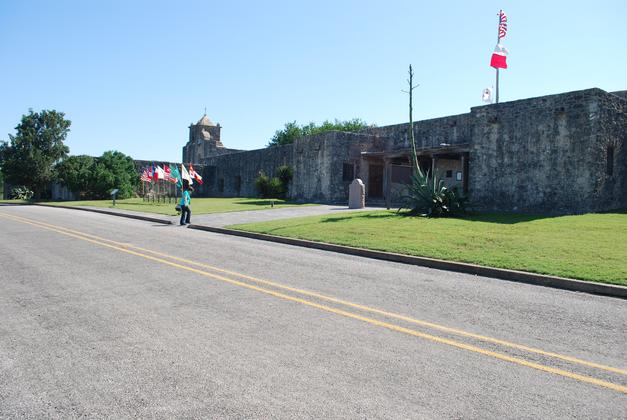
|
Front of the Presidio La Bahia.
|
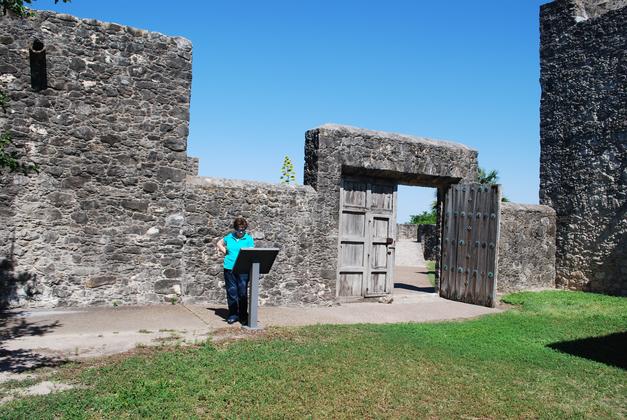
|
Betty reading the Fannin death plaque in front of the wall where he and the other wounded were shot.
|
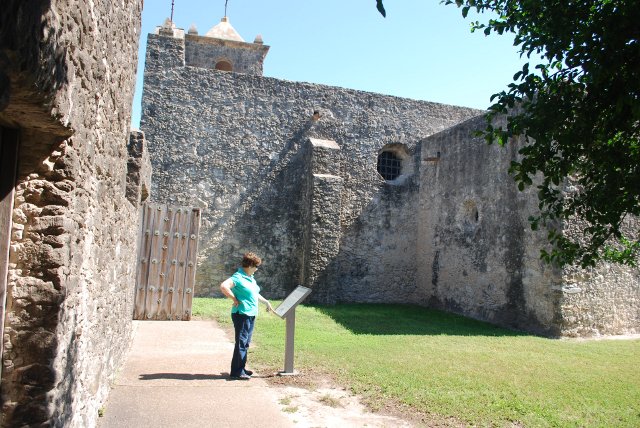
|
Another shot of Betty reading Fannin's death plaque showing the chappel on the north side where the captives were held.
|
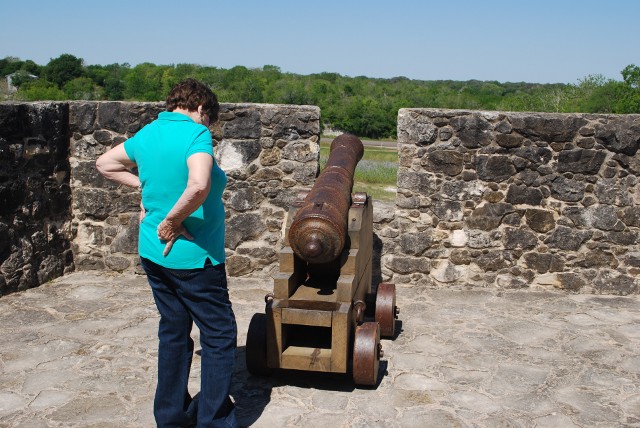
|
Cannon mount on the NW corner of the presidio.
On our trip Betty kept finding new firearms she really liked.
|
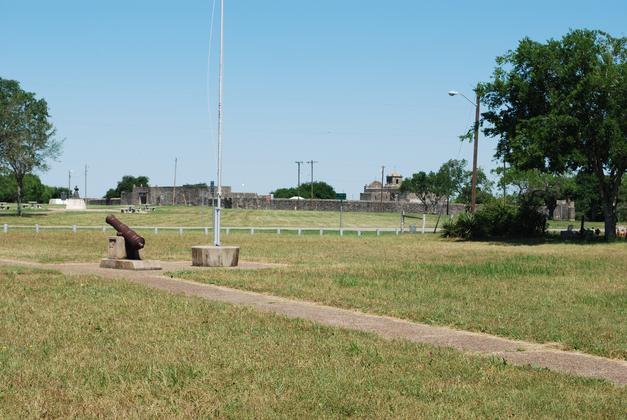
|
The presideo from the Fannin Monument, you can see the the Angel of Goliad Monument on the left.
The barracks is on the left, you can see the chappel on the far corner.
|
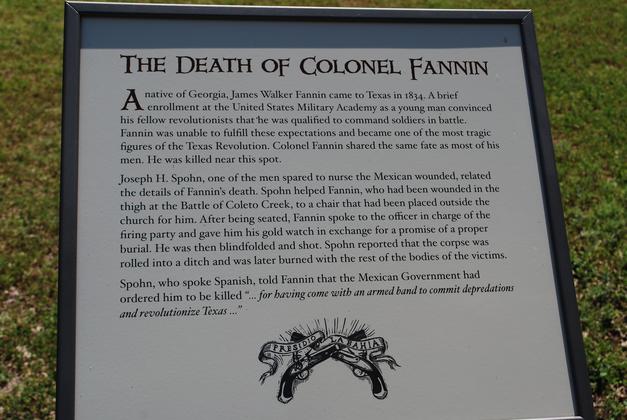
|
Plaque describing Fannin's death.
Click on the image to see a larger, hi-def image, it'll load slow.
|
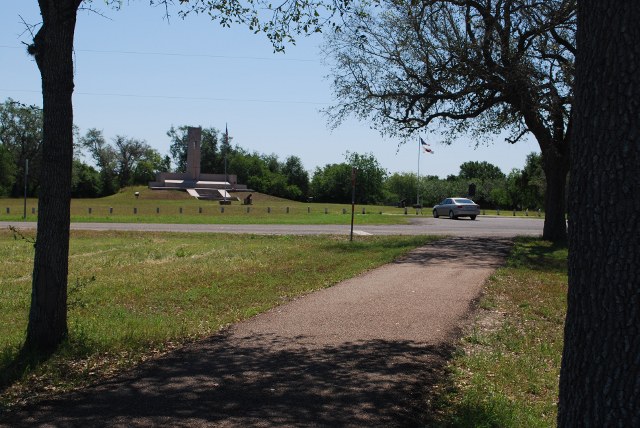
|
The Fannin monument from the Angel of Goliad monument, just south east of the presidio.
Note, ours is the only car in the parking lot.
|
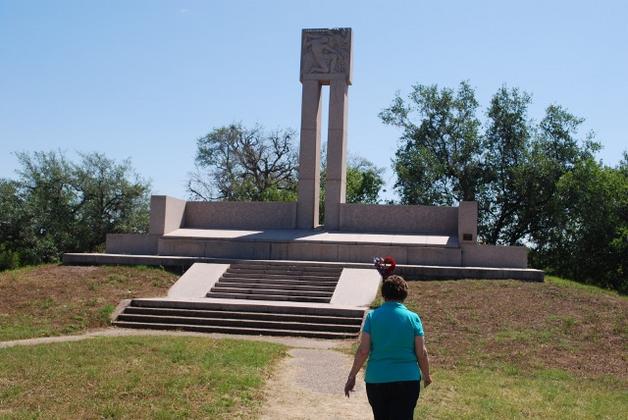
|
Betty approaches the Fannin Monument (Click on pic for hirez).
|
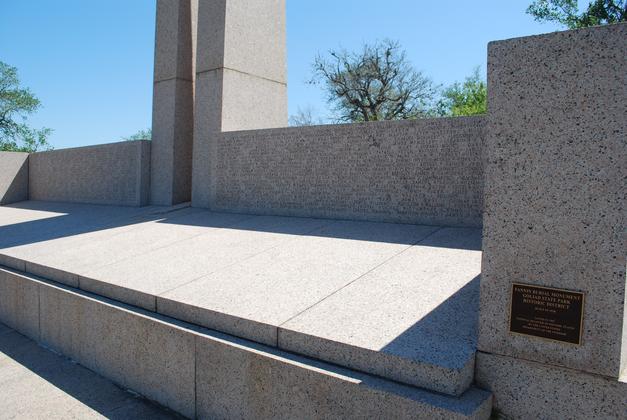
|
List of the dead on base of the Fannin Monument.
Click on the image for hi rez, you can read the dedication plaque on the right.
The list is too large for a single pic to show detail so I had to back up to even show the size of the list.
|
Coleto Creek Battle ground State Historical Monument Inscription:
After the fall of the Alamo, March 6,1836, Colonel James Walker Fannin, with about 400 soldiers, mostly volunteers from the United States in the Texas War for Independence, was ordered by Texas General Sam Houston to retreat from Goliad to Victoria. March 19, the heavy Mexican force of General Urrea surrounded the withdrawing Texas contingent near Coleto Creek, and bitter fighting ensued. Fannin's volunteers hurled back the assaults of the Mexican force. On the following day, faced with several times their number, the Texans surrendered in the belief they would be treated as prisoners of war of a civilized nation. After removal to Goliad, the Fannin men were marched out and massacred on Palm Sunday under orders of Santa Anna, the general of the Mexican armies. Thus dictator Santa Anna added another infamy to that of the Alamo and gave to the men who saved Texas at San Jacinto their battle cry, "Remember the Alamo, Remember Goliad". The memorial to Fannin and his men is near Goliad. (1974)
Fannin Monument State Historical Marker Inscription:
After battle of Coleto (March 19 - 20, 1836), where a Texas Army under Col. James Walker Fannin met defeat by Mexicans in superior numbers, the Texas soldiers were held in Presidio La Bahia, supposedly as war prisoners. However, by order of Mexican Gen. Antonio Lopez de Santa Anna, approximately 400 of Fannin's men were marched out and massacred on Palm Sunday, March 27, 1836. The wounded were shot one by one in the fort compound. Col. Fannin was the last to die. Because of their profession, Drs. J. H. Barnard, J. E. Field and Jack Shackelford were spared; about 25 men were saved by a Mexican woman, "The Angel of Goliad". Approximately 30 escaped by feigning death or by swimming the San Antonio River. The Texans' corpses were stripped and partly burned, but left unburied. This atrocity three weeks after the fall of the Alamo gave Texans part of the battle cry--"Remember the Alamo! Remember La Bahia!"--under which decisive victory was won at San Jacinto on April 21, 1836. Gen. Thomas J. Rusk and the Texan Army afterwards marched here and gathered the bones of Fannin's men from the terrain. From Presidio La Bahia the remains were carried in procession to the grave, and there given a military funeral and burial on June 3, 1836. (1968)








